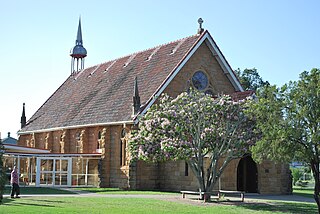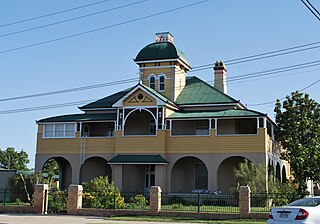
Leyburn is a rural town in the Southern Downs Region and a locality split between the South Downs Region and the Toowoomba Region in Queensland, Australia. In the 2016 census, Leyburn had a population of 476 people.

All Saints Anglican Church is a heritage-listed church at 32 Wickham Terrace, Spring Hill, City of Brisbane, Queensland, Australia. First founded in 1862, the current building designed by Benjamin Backhouse was completed in 1869, making it the oldest Anglican church in Brisbane. For most of its history, it has been identified with the High Church or Anglo-Catholic tradition within Anglicanism. It was added to the Queensland Heritage Register on 21 October 1992.

St Andrew's Church is a heritage-listed Anglican church at 2 Mangerton Street, Toogoolawah, Somerset Region, Queensland, Australia. It was designed by Robin Dods and built from 1911 to 1912 by local builder Donald Alexander Menzies at a cost of £839. It was added to the Queensland Heritage Register on 21 October 1992.

St Matthew's Anglican Church is a heritage-listed church at Beatrice Street, Drayton, once a town but now a suburb of Toowoomba in Toowoomba Region, Queensland, Australia. It was designed by James Marks and built from 1886 to 1887 by Seath, Hobart and Watson. It is also known as St Matthew's Church of England and is the second church of that name in Drayton. It was added to the Queensland Heritage Register on 21 October 1992.

St Mark's Anglican Church is a heritage-listed church at 55 Albion Street, Warwick, Southern Downs Region, Queensland, Australia. It is the second church of that name on that site. It was designed by Richard George Suter and built in 1868 by John McCulloch. It was added to the Queensland Heritage Register on 21 October 1992.

St Luke's Anglican Church is a heritage-listed church at 152 Herries Street, Toowoomba City, Queensland, Australia. It is the second church on the site and was designed by John Hingeston Buckeridge and built in 1897. It is also known as St Luke's Church of England. It was added to the Queensland Heritage Register on 28 July 2000.

St John's Anglican Church is a heritage-listed church at 153 Cunningham Street, Dalby, Western Downs Region, Queensland, Australia. It is the third church of that name on the site and was designed by Henry James (Harry) Marks and built in the 1920s. It is also known as St John's Church of England. It was added to the Queensland Heritage Register on 14 August 2008.

St Mary's Anglican Church, often called now St Mary's-on-the-Cliffs, is a heritage-listed churchyard at 433, 447 & 449 Main Street, Kangaroo Point, Queensland, Australia. It was designed by Richard George Suter and built in 1873 by Alfred Grant. It was added to the Queensland Heritage Register on 21 October 1992. Kangaroo Point Cliffs Park was constructed to the church's south in 2010 and a gateway allows park users to visit the church's grounds.

St Matthews Anglican Church is a heritage-listed church and cemetery at 35 Church Road, Mitchelton, City of Brisbane, Queensland, Australia. It was designed by Charles Tiffin and built from 1867 to 1869 by Mr Mahoney. It is also known as Grovely Church, as it is within the Parish of Grovely. It was added to the Queensland Heritage Register on 21 October 1992.

St Anne's Anglican Church is a heritage-listed church at Evanslea Road, Jondaryan, Toowoomba Region, Queensland, Australia. It is also known as the Jondaryan Homestead Church and St Anne's Church of England. It was built in 1859 by Hugh Bradford as a private chapel for the former Jondaryan pastoral station, and the first service was held by preacher Benjamin Glennie late that year. The church also served the new township of Jondaryan, and was moved to its present site, with alterations, in 1893.

All Saints Anglican Church and cemetery Yandilla is a heritage-listed Anglican church at Gore Highway, Yandilla, Toowoomba Region, Queensland, Australia. It was built about 1878 by John Baillie. It is also known as All Saints Church of England. It was added to the Queensland Heritage Register on 21 October 1992.

St James Church is a heritage-listed Anglican church at 145 Mort Street, Toowoomba, Queensland, Australia. It was designed by Richard George Suter and built from 1869 to 1953. It is also known as St James Church of England. It was added to the Queensland Heritage Register on 28 July 2000.

St Patrick's Cathedral is a heritage-listed Roman Catholic cathedral on James Street, South Toowoomba, Toowoomba, Toowoomba Region, Queensland, Australia. It was designed by Toowoomba architect James Marks and was built from 1883 to 1935. The site of the cathedral was originally a church and school known as St Patrick's Church School. In 1899, the school was moved to make way for the building of the cathedral and in 1959 renamed as St Saviour's School. St Patrick's Cathedral was added to the Queensland Heritage Register on 21 October 1992.

Anglican Church of the Good Shepherd is a heritage-listed church at 615 Brookfield Road, Brookfield, City of Brisbane, Queensland, Australia. It was built from 1892 to 1893. It was added to the Queensland Heritage Register on 28 April 2000.
Richard George Suter (1827–1894) was an architect in Queensland, Australia. Many of his buildings are now heritage-listed.

St Davids Anglican Church is a heritage-listed church at 1 Church Street, Allora, Southern Downs Region, Queensland, Australia. It was designed by Francis Drummond Greville Stanley and built from 1887 to 1901. It is also known as St David's Church of England. It was added to the Queensland Heritage Register on 24 March 2000.

Leyburn State School is a heritage-listed state school at Peter Street, Leyburn, Southern Downs Region, Queensland, Australia. It was built from 1883 to 1930s. It is also known as Leyburn National School. It was added to the Queensland Heritage Register on 21 October 1992.

Warwick Uniting Church is a heritage-listed church at 37 Guy Street, Warwick, Southern Downs Region, Queensland, Australia. It was built from 1869 to 1922. It is also known as St Andrews Presbyterian Church. It was added to the Queensland Heritage Register on 24 March 2000.

St Mary's Presbytery is a heritage-listed Roman Catholic presbytery of St Mary's Roman Catholic Church at 142 Palmerin Street, Warwick, Southern Downs Region, Queensland, Australia. It was designed by Wallace & Gibson and built from 1885 to 1887 by John McCulloch. It is also known as Father JJ Horan's private residence. It was added to the Queensland Heritage Register on 31 July 2008.

St Michael and All Angels Church is a heritage-listed Anglican church at 2-6 Alford Street, Kingaroy, South Burnett Region, Queensland, Australia. It was designed by Colin Deighton and built in 1911. It was added to the Queensland Heritage Register on 17 September 2010.

























